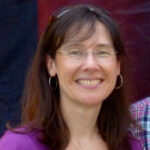By Carla Arnell

For the last decade, I have collaborated with undergraduate students in doing research about Evelyn Underhill and the Edwardian literary movements of which she was a part. At Lake Forest College, the small Illinois liberal arts college where I teach, each summer, students who have finished their first year with distinction have the opportunity to participate in what we call the Richter Honors Program. This program permits students to spend the summer working with a faculty member on his/her research, contributing to the professor’s ongoing projects and in turn receiving mentoring to learn the moves professional scholars make.
In 2007, I was looking for a new scholarly project to begin. I’d always been interested in the nexus between literature and spirituality, and I happened to recollect a course on “Mystics and Visionaries” that I’d taken years ago as an undergraduate at Augustana College. Oddly, even after so many years away from college, I still remembered the list of possible research topics my professor had given us – among which was the name of Evelyn Underhill. Having chosen a different mystic for my undergraduate project, almost twenty years later I didn’t know much about Underhill and thought the summer Richter program might be a great way to learn more in the company of eager apprentice scholars.
What began as a vague hunch that my students and I might enjoy researching Underhill became a decade-long fascination with Underhill, her work, and the literary movement of which she was a part. The two young men who worked with me during that initial summer would not initially strike one as predisposed to explore topics of either religion or spirituality, so I was heartened to discover that her fiction engaged and excited them. We read her three novels. We scouted out all of her short fiction and read it. We read the biographies of Cropper, Armstrong. and Greene and some of Underhill’s letters. And we worked that first summer mainly to get the lay of the land, putting together a comprehensive bibliography and trying to get a sense of some of the central scholarly issues animating discussions of Underhill’s work.
Working on Underhill that summer had been such a pleasure for both me and my first students (one of whom now has a Ph.D. in Philosophy), that I decided to repeat the project two summers later, and then again, and again, summer after summer, with each new set of Richter scholars focusing on a slightly different dimension of Underhill’s work. One summer, several students and I worked to understand the genre of fiction in which Underhill was writing. Should we regard it as “spiritual gothic,” for instance? We took that genre as our first working hypothesis by reading her work against the fictions of several other writers whose work we might classify thus (M.R. James, Algernon Blackwood, and Dion Fortune), trying to discern whether Underhill fit within this movement or was doing something distinctively different. During another summer, my students and I catalogued all the epigraphs that introduce her novels’ chapters, tracking down the sources of the epigraphs, learning more about the writers and texts behind the epigraphs, and using that catalogue to better understand the influences that shaped Underhill’s mind and heart. That work, which is still being shaped into an article, led to a subsequent summer’s research into the impact of the Arts and Crafts movement on Underhill’s thinking, a topic that has already issued in a scholarly article (published now in Studies in Medievalism).
As my research evolved, so did our understanding of how to classify Underhill’s fiction, an understanding that ultimately morphed into a book project (currently underway) on “Evelyn Underhill and the Rise of the Mystical Novel in the Edwardian Era.” Some of my most recent students have directly contributed to this book project, working to help me contextualize Underhill’s work within the Edwardian era’s fascination with mysticism and the occult and to situate her in relationship to like-minded writers of other “mystical novels,” including A.E. Waite, Arthur Machen, R. H. Benson, and Charles Williams.
That Underhill has engaged and delighted students working with me on this scholarly project for over a decade is a testament to her intellectual and spiritual richness, especially because my students were not all English or religion majors; indeed, during my summer projects, I worked with a math and economics major, a political science major, a neuroscience/physics double major, and a psychology major (who just went to law school!), to name only a few of the disciplinary fields represented among my Richter scholars. Although these diversely interested and talented students delved into many other writers of Underhill’s era, I found that students were often drawn back to Underhill herself, noting that she felt very “modern” to them, for they appreciated her aesthetic experimentation and found that her adventuresome and pioneering spirit resonated with them. She continues to be a writer for, if not of, our time.